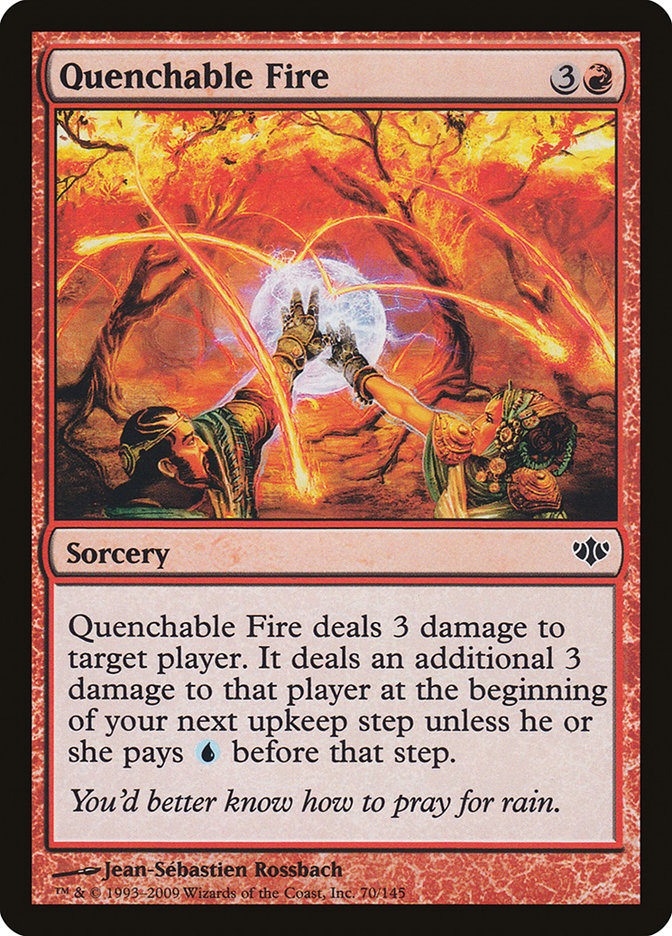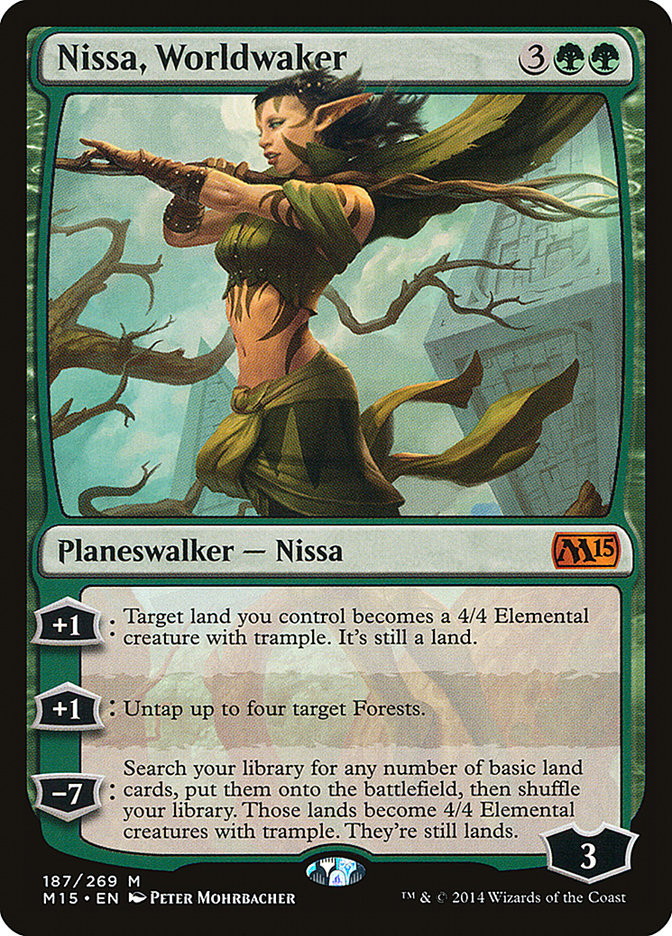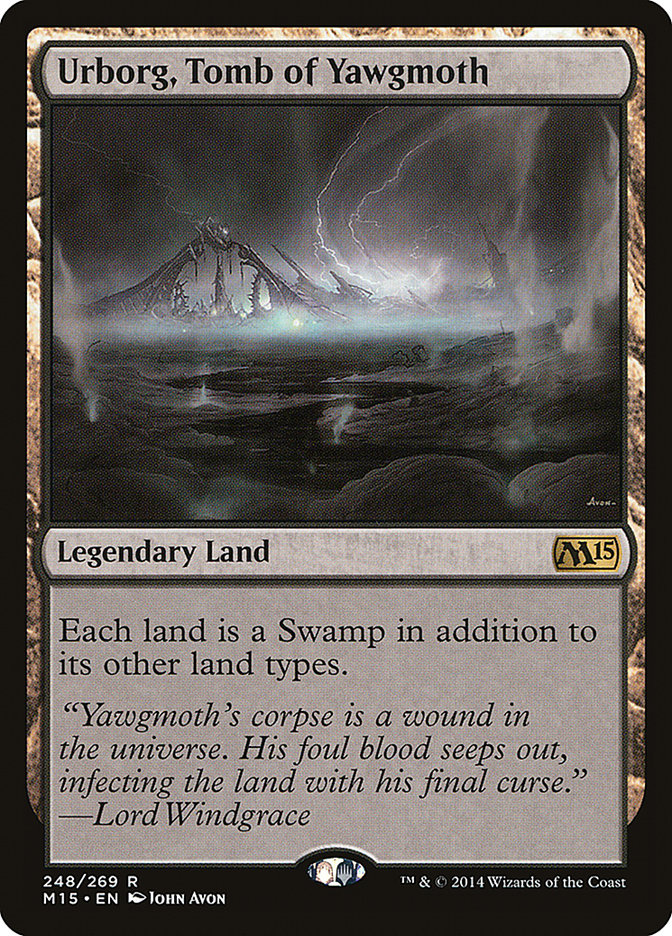Now that physical Magic 2015 cards are in my grasp, I’ll be kicking my Pro Tour testing into overdrive. I’ve spent the last couple of weeks working on notepads, proxy decks, and some playtesting against my roommate. I’ve been doing a fair bit of brewing new decks and adding Magic 2015 cards to the old ones. I’ve kept my testing group, Day1MTG, updated on my progress, and hopefully we’ll be bringing decks we can be very proud of to the Pro Tour.
This will be my fourth time preparing for the Pro Tour, and I’ve done it wildly differently each time. This week, I wanted to discuss how that process has changed and evolved, what I’ve learned from it, and how I hope to continue improving going forward.
Just kidding! I’m mostly going to tell humorous anecdotes with heavy-handed summary.
Pro Tour Kyoto, 2009
My first Pro Tour. I qualified by spiking a PTQ in Florida immediately following Grand Prix Atlanta, a tournament that qualified several talented Florida players for the PT and thus excluded them from the field. Amusingly, I’d entered the tournament for entertainment and a challenge after coming back to Magic following a hiatus; I had plans during the Pro Tour weekend. When I made Top 8 I mostly hoped to just scoop to Ben Stark, at that time in the process of his PT comeback, but he lost in the semifinals and left me no choice but to just win instead.
Anyway, the format would be Standard and I had to get cracking. I quickly identified the decks that were pretty good/popular: Fae, 5-Color Control, Kithkin, B/R Aggro, and the weird talk of the town: R/W Boat Brew. I latched onto B/R because I liked its matchup against Fae, the de facto “pro deck” of the day, and 5-Color Control which fit a similar profile. Given that I knew I was at a disadvantage on skill level, I wanted to employ an edge on deck.
The trouble came from Kithkin and Boat Brew. The common answer to Kithkin at the time was Chaotic Backlash, which punished the swarm-style creature deck for casting Cloudgoat Ranger and the rest of their army. However, I immediately realized Chaotic Backlash wasn’t suitable for a variety of reasons:
1) It cost five mana.
This meant that I had to draw five lands just to cast it, and if I was on the play, I wouldn’t be able to nab their Ranger with it until turn 6 unless I shipped turn with five open and convincingly whistled like someone with nothing to hide. Backlash costing five mana was also inconvenient because my fifth land would otherwise often enable two plays in the same turn, so this moved the stress of spellcasting later in the game, making me more vulnerable to beatdown.
2) They could play around it.
It’s really not that tricky to check the internet for popular sideboard cards. I imagined many players might even go to the extent of trimming some in anticipation!
3) It didn’t help me against Boat Brew.
I had two bad matchups that needed attention, and Backlash wasn’t good enough to board in against Boat Brew. I lost to both decks in relatively similar ways and needed something that could extend my reach against each of these decks. What Chaotic Backlash actually did was fine–when it worked. That sent me searching for similar cards that cost less or at least did their job more consistently.
One day, one of my friends suggested Quenchable Fire, in all likelihood as a joke.
Reading it, I had a feeling it was what I wanted. So I tried it, and kept trying it, and it kept performing.
I played Quenchable Fire at the Pro Tour, and I got some weird looks, but it worked. I don’t think I lost a match to Kithkin (I’m quite certain I won two, can’t recall if there was a third one either way), and I split my matches against Boat Brew.
Lesson: Figure out the job, and then find the tool–whether the tool looks funny or not.
I was on the verge of being eliminated from Day 2 but managed to 3-0 the draft and wound up finishing just outside the money. This was somehow still strangely exhilarating for me: I had played well with my back to the wall (a typically weak point for me), I’d proved that my perceived Florida-derived Limited competence wasn’t completely imaginary, and I’d had a not completely embarrassing showing at my first Pro Tour.
This Pro Tour changed a lot about how I played and experienced Magic. At the time, I wasn’t especially good friends with many of the Florida players, having been on hiatus as I mentioned. That’s how I wound up testing with my friends at the University of Florida. Many of them played Standard pretty actively, which led to a ton of games at the (literal) kitchen table.
For the event itself, I wound up rooming with John Cuvelier, Charles Gindy, Chris Fennell, and Julian De Los Santos–a crew of which I was and likely remain the worst Magic player, although it’s certainly a closer fight today than it was in 2009.
Lesson: When rooming with a ton of people, shotgun the rollaway–no one will ever try to share it.
I didn’t work with them at all leading up to the event, but we talked a lot just before and during the Pro Tour. I also wound up meeting a lot of players from around the country for the first time, notably Gerry Thompson, Cedric Phillips, Ari Lax, AJ Sacher, and many more. My Magic peer group expanded exponentially that weekend, and I realized how large the gap between myself and the top really was. It was humbling, but a good lesson–I can probably trace my obsession with objective self-evaluation back to this event.
Building connections with players much stronger than myself did and continues to afford me with a lot of great opportunities for improvement. I started helping the qualified Florida players prepare for upcoming Pro Tours when I could, making time for practice drafts and loaning cards for Constructed. When I moved to Roanoke, we did more of the same. For Pro Tour Journey into Nyx, I playtested Draft and Constructed on behalf of a few qualified players in the SoCal area as well.
Lesson: Playing on the Pro Tour takes a village.
But I’m getting ahead of myself.
Pro Tour Honolulu
I managed to win a PTQ in the very next season playing Owen Turtenwald’s Faeries list in Extended upon the recommendation of David Irvine. That Pro Tour was Block Constructed, and I’d decided that I could prepare for it alone thanks to Magic Online.
Ok, so not every lesson takes on the first go.
I did playtest a lot on Magic Online, and like many players, I immediately realized that Uril, the Miststalker was going to be very good. With Jund the de facto best deck in the format, Uril was near-impossible to remove and could block the vast majority of playable threats. I was so confident in my read that I bought twenty copies to take with me to Hawaii just to sell!
My failure was that I didn’t know the difference between “very good” and “format-defining.” I knew Uril was good, but I mostly spent time looking for existing decks that could wield him–I didn’t try to build decks that would leverage his particular set of skills. This colossal failure meant I never even tried a version of Cascade Control remotely similar to what wound up being one of the tournament’s best decks.
Lesson: When cards are good enough, they breathe new life into archetypes and might even create new ones.
Does anything in Magic 2015 have that kind of potential? The frontrunners are Ajani Steadfast and Nissa, Worldwaker, if you ask me. They both offer a unique gain to two underplayed strategies.
Fortunately, a resurgent Ben Stark had made the same foolish mistake that I did and booked an extra week in Seattle after the GP rather than flying straight to Honolulu and needed a place to crash. I’d already lined up a friend’s house locally, and that led to a week of playing Magic non-stop with a Hall of Famer and arguably the greatest Limited player of all time.
Sadly, we mostly tested Constructed.
Even more sadly, it was mostly various flavors of Jund.
I kid. In truth, I learned a lot about how to approach Magic that weekend, and I have Ben to thank for that. He’s truly one of the greats.
Ben and I sort of accepted Jund’s dominance as a foregone conclusion. It was crushing Magic Online, it had the strongest selection of cards, and there were no apparent challengers. We decided to build a Jund deck that would beat other Jund decks and Uril, and we did; we played Slave of Bolas and eschewed the staple Maelstrom Pulse in order to maindeck Fleshbag Marauder.
Fun story: Mere minutes before the event, Osyp Lebedowicz himself ran up to the table, told Ben he’d do whatever he said, and asked Ben what to play–Ben told him to go pay $32 for 4 Fleshbag Marauders from the dealer and to unsleeve his Maelstrom Pulses.
Osyp stared at Ben for five seconds before saying “Okay!” and doing exactly that en route to a Top 64.
Anyway…
Zac Hill’s team (among others) solved the 5-Color deck while Paul Rietzl and Brian Kibler’s team solved the format with Esper Stoneblade, a deck that was truly greater than the sum of its parts. I remember watching Kibler play a match nearby in the early rounds (we weren’t in the same bracket for long!) and feeling not just stupid, but ill-equipped as a Magic player. Their deck was so good on so many levels, and I hadn’t just missed it–I’d never even considered something remotely like it.
I’d essentially had on blinders. I figured out the good cards and good decks that were readily available, but I tried to outperform them rather than going back through the format to look for the ways I could beat them. I didn’t look for unique angles; all my decks played Exotic Orchard, none of them ran a bunch of Borderposts to turn it off!
Lesson: Once you learn the format, explore it–and then learn it again with new eyes.
I’m currently in the midst of this process for Portland.
A caveat: Interestingly enough, in Seattle Ben had said he felt that there was a good Esper deck based on the power of Esper Stormblade. When I asked him how to start brewing it, Ben advised me not to try. His reasoning was that we’d have less than four days to try and make it work–if we failed to produce a PT-caliber deck with all of that effort, we’d have squandered our testing time for nothing.
The solution? Start testing earlier! I realized I’d squandered my MTGO time horribly by grinding all the decks everyone else had, rather than using it to try out ideas and see if there was anything unique.
Lesson: When pressed for time, the best version of a good deck is a safer bet than a brew. Reserve the first couple weeks for brews, then focus on what’s working.
I imagine we may see this in full effect in Portland. I can’t say one way or the other whether I think a new deck will break out, but I imagine many players–especially those without teams–will be adding an Urborg, Tomb of Yawgmoth to their Mono-Black deck and calling it a day.
Of course, despite my errors in preparation for this Pro Tour, I doubt any of them could’ve improved my result. I got incredibly ill shortly after landing, and by Sunday morning, I was literally incapable of speaking aloud. I thought I was dying for an entire weekend, and I could do nothing but drown my sorrows in pineapple, pork, and drafts.
Lesson: Don’t get the flu before the Pro Tour.
Let’s move on.
Pro Tour Amsterdam
Amsterdam was an odd qualification. After going on a very strong run over the course of a couple events, I saw that my DCI rating–for you kiddos, my Planeswalker Points that went down when I lost–had landed at about 1980. After a quick check at previous ratings invites, I realized that qualifying via rating wasn’t outside of my reach, and I began grinding local events.
The draft format was Rise of Eldrazi, which I loved and happened to be very good at. I played every draft in driving distance for about two months, and at the end of that stretch I’d put together an absurd record of approximately 47-3 with about three concessions along the way to qualify. In hindsight, this seems significantly more incredible to me–the idea of even approaching 90% in any format is just insane.
Bonus Lesson: Essence Feed is the NUT.
I haven’t found a sleeper in M15 yet, but I’m on the hunt. It’s disgusting to me that Research Assistant is actually quite decent in Sealed. Adam Prosak has clearly convinced the rest of Wizards that Merfolk Looter actually was broken.
Amsterdam was Extended, and I worked with David Sharfman and Billy Postlethwait. Once more I was talking shop with people better at Magic than me, but this time we were preparing together! I had the Ad Nauseam deck pretty early and was very excited about it, but then it broke all over Magic Online, and I knew we couldn’t play it. Punishing Fire was defining a lot of midrange mirrors, so the field was mostly splitting into combo, Jund-style decks, and control online.
Sound familiar?
I knew that Jund had the most overlap against combo and control thanks to a clock and disruption, so I was once more looking to break the Jund mirror. As has become conventional in Modern, I turned to white. No Lingering Souls in 2010, though–just Doran, the Siege Tower and friends.
The most important gain Doran made besides himself was actually Murmuring Bosk. Remember, this was Extended–our fetchlands didn’t find many nonbasics with shocklands not being legal. I honed our Doran list obsessively to the point where we were balling out of control with maindeck Ethersworn Canonists and sideboarding Consuming Vapors and Deathmark for the midrange mirrors. I felt like I’d gave it my all and we had a great deck, and I was right. When Ben came up to us the day before the Pro Tour looking for Treefolk Harbingers, I felt even more confident.
So what did I @#$! up?
Well, for starters, I didn’t sleep before the Pro Tour. It wasn’t a result of me being stupid–my roommate, Cliff Weixler, had tripped and shattered his knee late at night returning from the site, and I’d stayed up alongside our third, Logan Mize, keeping him company, collecting his luggage, and helping to arrange his flight home. Cliff was distraught, between the significant injury and the fact that he was going to miss his first Pro Tour–fortunately, he was extended a special invitation to make up for it.
During the first round, I played a turn 1 Verdant Catacombs for Forest over a Misty Rainforest, and I saw the writing on the wall. The correct play in that instance should’ve been autopilot, but mine was no longer functional–it had fallen asleep. Until this event, I hadn’t consciously acknowledged I was mortal in this way,
Lesson: Being well-rested actually is important.
Portland will be the first Pro Tour I’ve played that’s less than six time zones away from me, which is good; I’m getting old.
After my quadruple Assassinate draft deck managed to overcome Serra Angel and Sword of Vengeance in the penultimate round, I was defeated by Rotting Legion… on the splash. Insult to injury, indeed.
I watched Billy and Sharfman pilot the deck into the Top 16 and Top 64 respectively, while battling side events and enjoying the efforts of the city’s talented bakers. And as I watched Paul Rietzl win with tiny white creatures, I was reminded of how I’d felt in Honolulu. Like I’d missed something huge that an entire group of people had managed to see. Once more the deck of the tournament wasn’t just a deck I hadn’t tried, it was a deck I hadn’t imagined.
White Weenie was so simple, so efficient, so pure. It had so many efficient cards that, taken together, the deck just operated in constant control of initiative. For an aggressive deck filled with tiny creatures to be the best deck in a tournament that included one-drop 0/3s in one of the best decks and Punishing Fire in another, it better be something pretty special… it was.
My last two Pro Tours saw me fail to so much as identify the best deck twice. I’m not eager to make that mistake a third time, but Portland beckons.
Man, this article could look really awkward come August 3rd.





